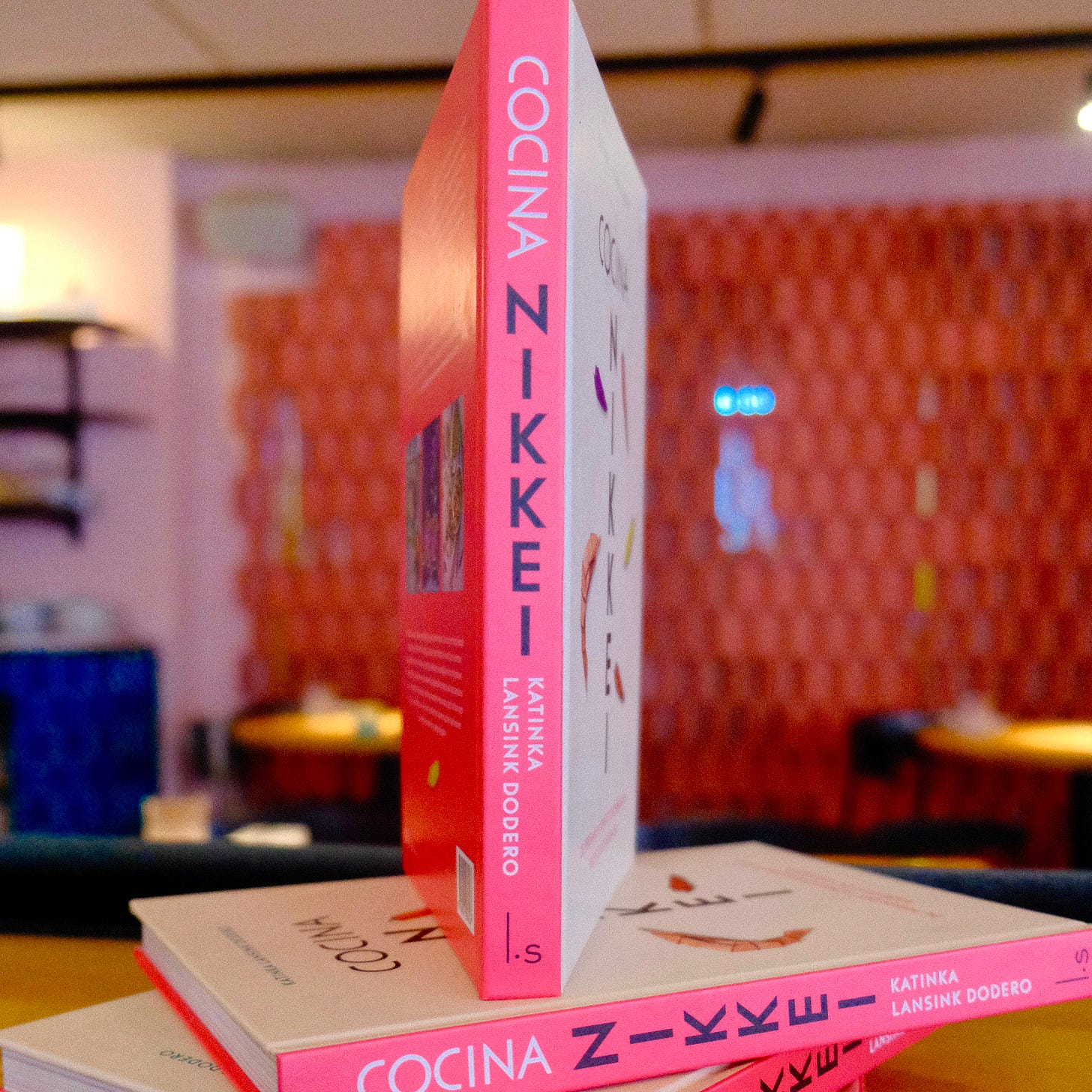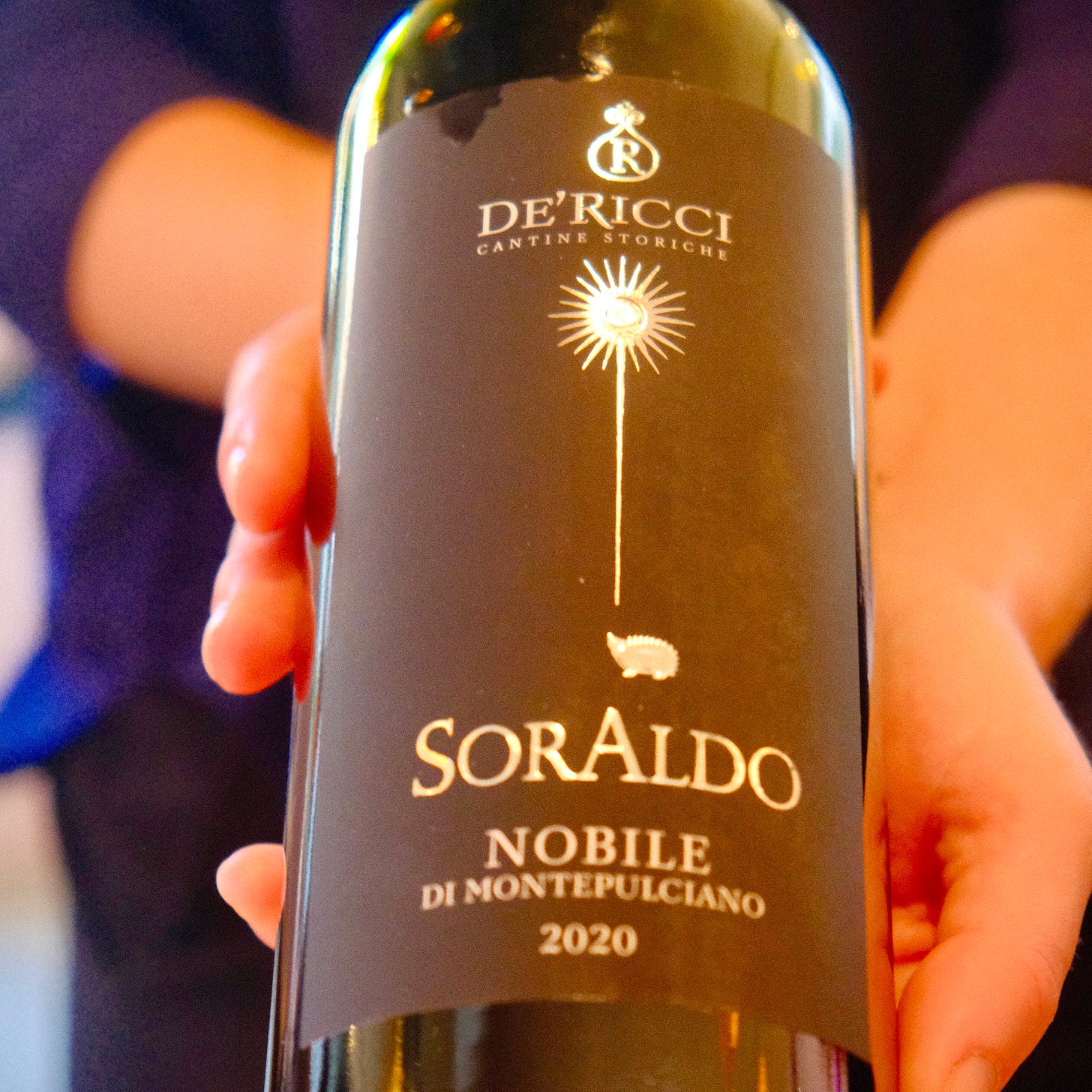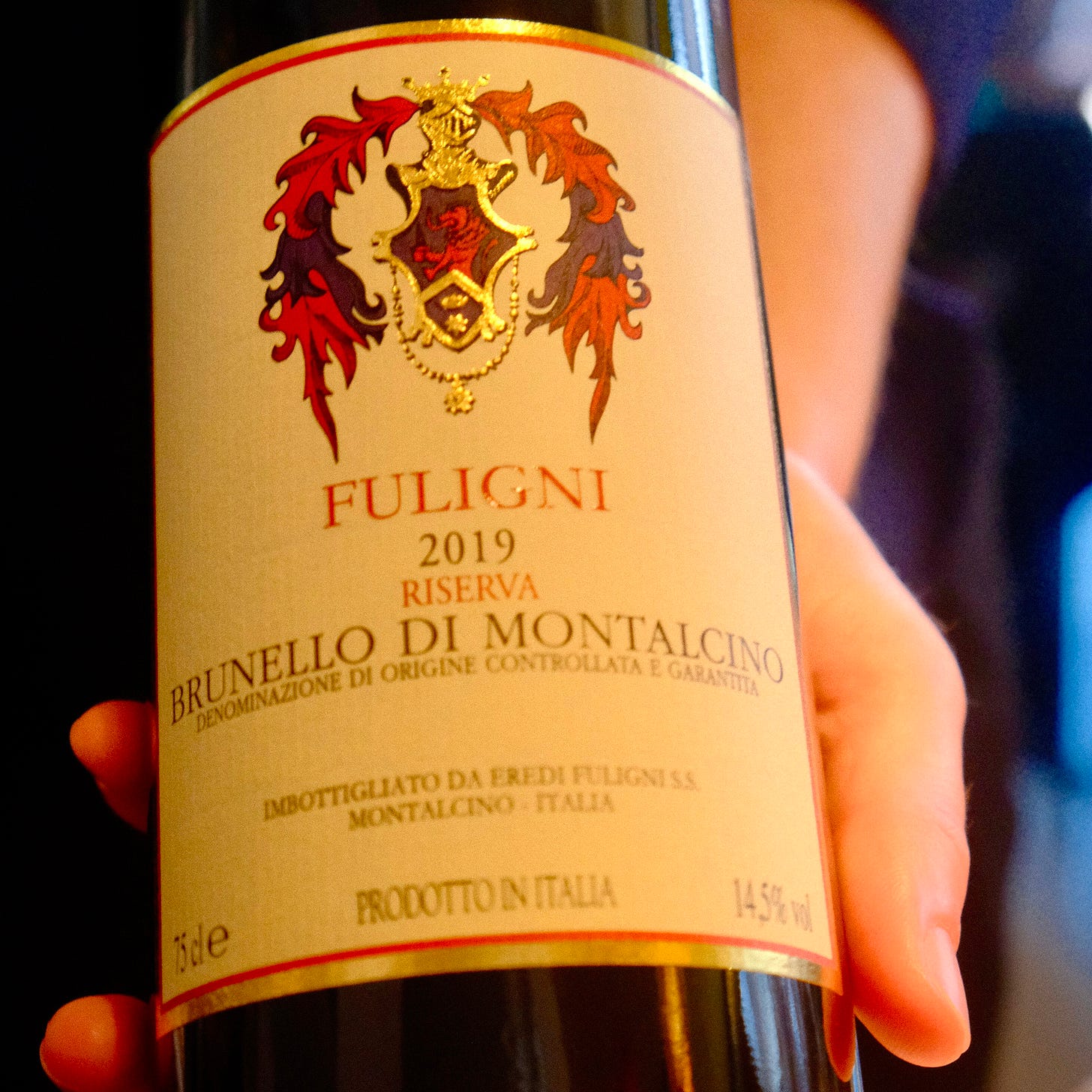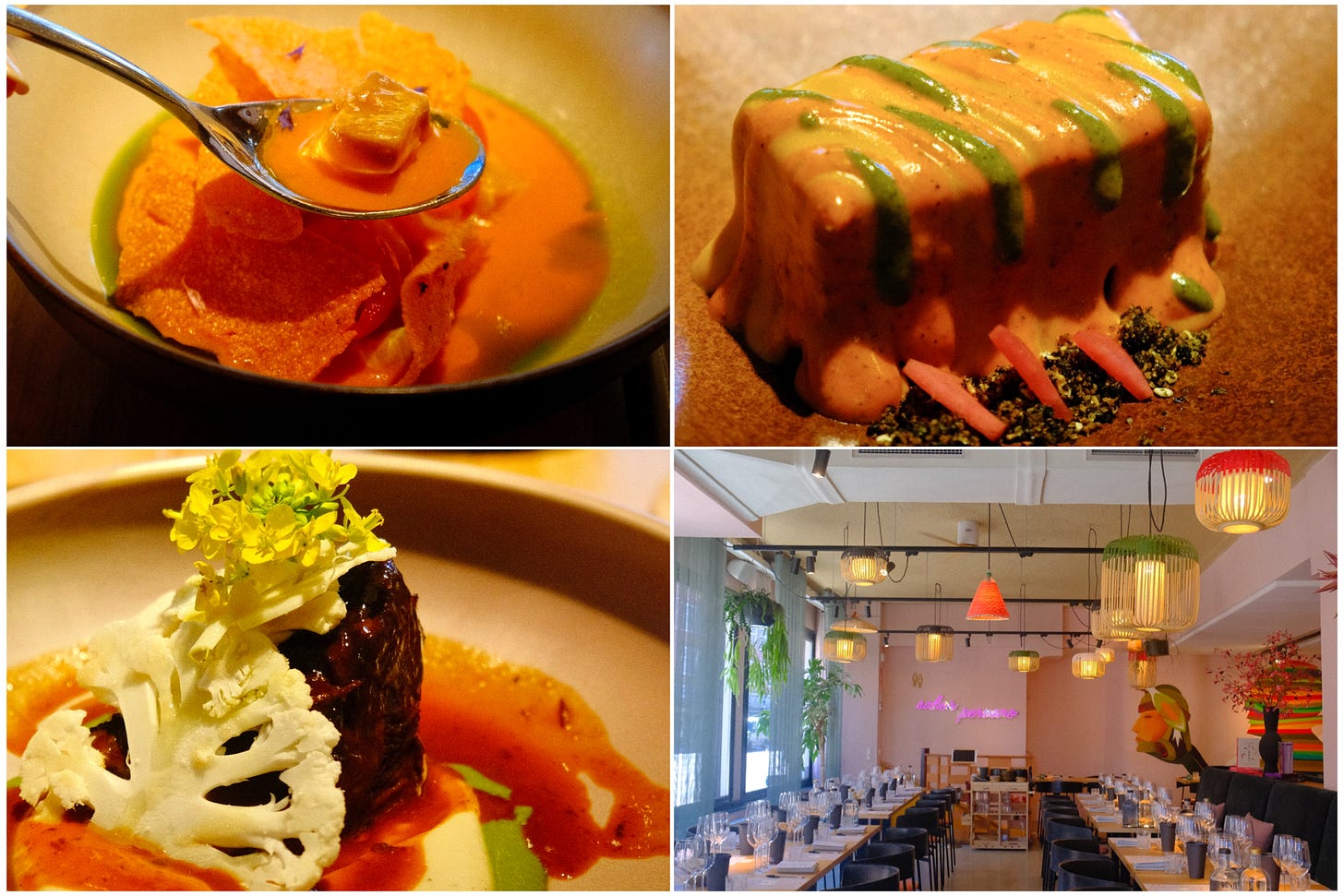Fusion Confusion? Italian Reds Meet Nikkei Peruvian Spice
A deep dive into Nikkei flavors, capsaicin chemistry, and rule-breaking wine moments
If you’ve ever stood in front of a wine shelf wondering what to pair with fusion food—or work in a shop where your clients do—this one’s for you.
This week, I attended an Italian wine tasting—hosted not in Tuscany, but at Nazka, a modern Peruvian restaurant in Amsterdam. The lineup featured Rosso and Brunello di Montalcino, as well as Vino Nobile di Montepulciano from three classic Tuscan producers: De’Ricci, Fuligni, and Pian delle Querci.
The wines came first—each poured and introduced on its own merits. Then came lunch: a three-course modern Peruvian menu. No pairings were prescribed. Instead, we were left to make our own discoveries.
That’s when my wine brain switched on—not for critique, but for pairing.
Braised ox cheek? A structured red was a no-brainer.
But seabream crudo with chili and coriander oil? That sparked real curiosity.
In this post, I reflect on how bold, layered Nikkei-Peruvian flavors interacted with traditional Tuscan reds—and along the way, I explore the wines themselves, their origins, and a few surprising pairings that worked far better than expected.
Nikkei Peruvian Cuisine: A History of Fusion
Nikkei is derived from the Japanese word nikkeijin, meaning Japanese emigrants and their descendants. Today, it also refers to a culinary tradition born from the cultural fusion of Japan and Peru—one that has gained global recognition.
Two decades ago, I backpacked through Peru for three months, eating my way through street-side anticuchos, plastic-bag ceviche, and endless bowls of rice. The flavors were bold, hearty, and deeply local—and somehow familiar. Rooted more in humble tradition than haute cuisine, many dishes echoed Japanese food culture. Back then, I never imagined those same flavor foundations would end up in tasting menus at the world’s top restaurants.
And yet, here we are. Over the past ten years, Peruvian cuisine has taken center stage in global gastronomy. Chefs like Virgilio Martínez (Central), Pía León (Kjolle), and Mitsuharu 'Micha' Tsumura (Maido) have redefined what’s possible with native ingredients, regional ecosystems, and cultural memory. I haven’t returned to Lima since that first trip, but it’s now high on my list—firmly established as one of the world’s most exciting food capitals.
But even before Michelin stars and World’s 50 Best rankings, Peruvian cuisine was already global. It has always been about layers—geographical, historical, and cultural.
The Inca Empire cultivated over 3,000 types of potatoes and built a culinary system around altitude and terroir. Spanish colonizers brought citrus, onions, pork, and beef. And in the late 19th century, waves of Japanese and Chinese immigrants added soy, rice, seafood techniques, and fermentation. Even ceviche owes something to that legacy.
From that convergence emerged Nikkei cuisine—a Japanese-Peruvian hybrid that feels both futuristic and deeply rooted. Dishes like tiradito, seabream crudo, and anticucho-marinated wagyu are no longer just “fusion.” They’ve become a genre of their own.
Every time I come to Nazka, I find myself smiling at the little things that remind me of Japan—whether it’s the way something’s seasoned, a familiar topping (this time, seaweed sprinkle, called Furikake), or a subtle twist in flavor. There’s always a hidden Japanese touch waiting to be discovered.
Nazka leans into that Nikkei-Japanese fusion, but honestly, that’s what I love about dining out in the Netherlands. So many restaurants here play with flavors—especially across Asia—in ways that are clever, surprising, and just plain fun.
It’s like culinary déjà vu... with a twist.
What struck me most at Nazka this time was this: the food wasn’t trying to pair with the Italian wine. It was simply being itself—vivid, spicy, textural, unapologetically hybrid. Which meant the wine had to rise to the challenge. That’s what I thought.
Nazka Menu Overview (with Ingredient Notes)
Rocoto (chili) LDT – Seabream crudo (raw), cherry tomatoes, cancha (toasted corn), coriander oil
→ A refreshing, slightly spicy starter with a zesty Peruvian chili sauce and textural crunch.
Vinicunca Millefeuille – Layers of oca (Andean potato) tubers with Peruvian chili sauces with seaweed furikake.
→ Earthy, colorful, and gently spicy—evoking the layered hues of Rainbow Mountain (Vinicunca).
Braised Ox Cheek – In anticuchera sauce (vinegar-spice marinade), choclo (large white corn) mousseline, green chalaca herb salsa
→ Deeply savory beef, mellowed by creamy corn and lifted by a herbal, umami-packed finish.
Spice, Capsaicin & Wine: The Chemistry of Challenge
Before we talk about wine, we need to talk about spice.
Spiciness isn’t a flavor—it’s a sensation. It activates the same receptors in our bodies that detect heat and pain. According to the Hong Kong University of Science and Technology, chili peppers contain an alkaloid called capsaicin, the compound behind that burning feeling.
Capsaicin is hydrophobic, meaning it repels water but dissolves in fat. It’s also amplified by alcohol, which acts as a solvent and spreads the burn.
That’s why wine pairings often fall apart with spicy dishes. A wine that once tasted smooth and round can suddenly feel hot and aggressive—especially if it’s high in alcohol or tannins.
But spice doesn’t always ruin a pairing. When combined with fat, sweetness, or cooling herbs, capsaicin becomes far more manageable. I’m no spice expert, but I enjoy reading takes from sommeliers in spice-forward cultures. Some wines—particularly those with generous fruit, soft tannins, or a touch of sweetness—can meet the challenge.
Also, as the WSET textbook reminds us, spice tolerance is personal. Some diners crave bold reds with chili-heavy food. Others prefer the relief of an off-dry white.
It’s not just chemistry—it’s personality.
Spice reveals where your limits lie—and where wine might surprise you.
So, How Did the Tuscan Reds Perform?
🍷 De’ Ricci
Located in the heart of Montepulciano’s old town, De’ Ricci is as historic as it is beautiful. Its Renaissance cellar, dubbed the Cathedral of Wine, is as iconic as the wines themselves. The estate has farmed organically since 2007, focusing on Sangiovese-based expressions.
Rosso di Montepulciano 2022 – 90% Sangiovese and 10% Merlot. Ripe red plum, gentle herbs, bright acidity, and soft tannins. A lively aperitif style—and a surprisingly good partner to the spicy seabream crudo (hopefully, slightly chilled).
Vino Nobile di Montepulciano 2021 – 100% Sangiovese aged 18 months in large barrels. Juicy red berries, subtle spice, refreshing acidity, and firm tannins. A balanced, classic wine.
Vino Nobile di Montepulciano “Soraldo” 2020 – The estate’s flagship. From 22-year-old vines at 500m elevation on limestone-rich soils. Aged 24 months in wood and 12 months in bottle. Notes of red and black cherry, cocoa, and coffee—rich and refined. My personal favorite of the day.
🍷 Pian delle Querci
A traditional family-run winery near Montalcino with 8.5 hectares under vine, including both Rosso and Brunello. The vines are planted on clay-limestone soils at 250m elevation.
Rosso di Montalcino 2021 – Bright, youthful Sangiovese with generous red fruit and freshness. Easy to like.
Brunello di Montalcino 2020 – Ripe and rounded, with red fruit, spice, and a soft texture.
Brunello di Montalcino Riserva 2019 – Subtle nose, smooth and warm on the palate with length and poise. Drinking beautifully now.
🍷 Fuligni
Set between 380–450m elevation, Fuligni is known for crafting elegant, age-worthy Brunellos with restraint and polish.
Rosso di Montalcino ‘Ginestreto’ 2023 – Aromas of cherry, strawberry, chocolate, and lavender. Rhubarb and sour cherry on the palate, framed by silky tannins and mineral lift.
Brunello di Montalcino 2020 – A juicy vintage with bright cherry, rosehip, earth, tobacco, and wild herbs. Balanced and nuanced.
Brunello di Montalcino Riserva 2019 – Deep and graceful, especially after decanting. Black cherry, raspberry, licorice, baking spice, and velvety tannins. Outstanding wine.
Still Curious: What Else Might Work?
Nikkei food—this Japanese-Peruvian hybrid—was doing fusion long before it was cool. Born from migration and adaptation, it’s now at the cutting edge of global dining.
Pairing wine with it, though? That’s where things get unpredictable—and fun.
If I were drinking solo, I’d reach for the Vino Nobile di Montepulciano “Soraldo” 2020 or the Brunello di Montalcino Riserva—structured, elegant, and deeply satisfying wines with serious potential.
But the wine that stopped me in my tracks?
Rosso—with spicy seabream crudo.
I expected it to clash. Chili, oil, raw fish? Everything said no.
And yet... it worked. Not textbook. Not perfect. But exciting.
The creamy fat and sweet tomato softened the spice. The wine held its ground.
It made me rethink what’s possible.
I’d still love to try the dish with a Godello or Gewürztraminer.
But the Rosso surprised me—and that’s what stuck.
Ever had a pairing like that—where the unexpected became the highlight?
Let’s Pair the World
Ever had a pairing so unexpected it made you double-check the label? Chili and Rosso? Seabream and Sangiovese? These are the moments that keep wine exciting—and honestly, way more fun than textbook pairings.
I’d love to hear your wildest match. Was it brilliant or a beautiful disaster?
Drop it in the comments, reply to this post, or DM me on Instagram (@kazuming.wine.food). If it's spicy enough (figuratively or literally), I just might feature it in an upcoming Friday post.
🍷 Next up: I’m heading to a Jura wine lunch at BAK Amsterdam. Think oxidative whites, mountain reds, and... a very modern tasting menu. What could go wrong? Stay tuned.
This post is part of my Friday series on Asian food and wine, and complements my Tuesday Sake 101 series, where I explore the fundamentals of Japanese sake through a wine-lover’s lens.
Thank you for reading Pairing the World: Wine, Sake, and More!
Each post involves hours of tasting, research, and reflection—plus the occasional existential crisis over spice levels.
👉 If you enjoyed this and want more pairings, unexpected wine finds, and cultural flavor journeys, hit that free subscribe button below. Let’s explore the delicious unknown together.
時間短縮に日本語で読みたい方へ(AIを使って翻訳しています)
フュージョンの混乱? イタリア赤とニッケイ料理の出会い
ペルー×日本のスパイシーな料理に、クラシックなトスカーナの赤は合うのか?
もしあなたが、フュージョン料理にどんなワインを合わせるべきか迷ったことがあるなら——あるいは、そんな質問をお客様からよく受けるワインショップのスタッフなら——今回の投稿はきっと役立つと思います。
今週は、トスカーナではなく、アムステルダムのモダン・ペルー料理レストラン「Nazka」で開かれたイタリアワインのテイスティングに参加しました。ラインナップは、RossoとBrunello di Montalcino、そしてVino Nobile di Montepulciano。提供したのは、De’ Ricci、Fuligni、Pian delle Querciというクラシックな3つのトスカーナ生産者。
ワインが先に登場し、それぞれの魅力を説明。続いて、ニッケイペルー料理3品のコースランチがサーブされました。ペアリングはあえて提示されず、各自で発見してねというスタイル。
そこで私の“ワイン脳”が作動。頬肉の煮込みには、しっかりした赤が合うのは当然。でも、チリとコリアンダーオイルで和えた鯛のクルード?それはさすがに難しいだろう...と思いきや。
今回の投稿では、こうした力強くレイヤーの重なったニッケイペルー料理と、伝統的なトスカーナの赤ワインがどう交差したのかを振り返りながら、各ワインの背景や、意外にも“合ってしまった”組み合わせを紹介しています。
ニッケイペルー料理:フュージョンの歴史
「ニッケイ」という言葉は、日本からの移民やその子孫を意味する「日系人」に由来します。そして今では、日本とペルーの文化的融合から生まれた料理ジャンルの名前として、世界的に知られるようになりました。
20年前、私は3か月かけてペルーをバックパック旅行しました。屋台のアンティクーチョ(串焼き肉)や、ビニール袋入りのセビーチェ、そしてどこでも出てくるたっぷりの「ご飯」を食べながら、ペルー、ボリビア、チリ、エクアドルの都市を巡りました。ペルー料理の味わいは力強くて温かく、とてもローカルで――それなのに、どこか懐かしい。洗練された高級料理というよりは、素朴な家庭の味に近く、多くの料理に日本的なニュアンスが感じられました。当時は、これらの味の原型が、いずれ世界トップのレストランのテイスティングメニューに登場するとは夢にも思いませんでした。
けれど今、現実はそうなっています。ここ10年ほどで、ペルー料理は世界のガストロノミーの最前線に立つようになりました。たとえば、ヴィルヒリオ・マルティネス(Central)、ピア・レオン(Kjolle)、ミツハル “ミチャ” ツムラ(Maido)といったシェフたちは、土着の食材や地域生態系、文化的記憶をベースに、「料理の可能性」を根底から刷新しています。あの旅以来リマには行っていませんが、今や世界で最も刺激的な食の都のひとつとなったリマを、もう一度訪れたい気持ちが高まっています。
とはいえ、ミシュランや「World’s 50 Best」の評価が出るずっと前から、ペルー料理は世界的だったのだと思います。“層”を持つ料理――地理的にも、歴史的にも、文化的にも。
インカ帝国の時代には、3,000種を超えるジャガイモが栽培され、標高や土壌を活かした独自の食文化が築かれました。スペインの植民地支配がもたらしたのは、柑橘、タマネギ、豚肉や牛肉。そして19世紀後半には、日本人や中国人の移民が、醤油や米、魚介の技術、発酵文化を持ち込みました。セビーチェにだって、そうしたルーツがあります。
そうした融合のなかから生まれたのが「ニッケイ料理」。それは未来的でありながら、深く根ざしたハイブリッド。ティラディート、鯛のクルード、アンティクーチョ風にマリネした和牛など、「フュージョン」では片づけられない、ひとつのジャンルとして確立されています。
Nazkaを訪れるたびに、私は小さな“日本”を見つけて微笑んでしまいます。味つけ、トッピング(今回はのりのふりかけ!)、あるいは風味のちょっとしたニュアンス。いつもどこかに、密やかに仕込まれた日本的エッセンスが感じられるのです。
Nazkaは、Nikkei×Japaneseという軸をはっきり持っています。でも正直、こういう楽しさがあるのがオランダの外食文化のいいところ。とくにアジア料理において、味覚の掛け算に長けたレストランが多くて、意外性と発見の連続です。
「どこかで食べたことあるような味」なのに、「こんなの初めて」――そんな“デジャヴのひねり”があるのが魅力。
今回、特に印象に残ったのは、料理がイタリアワインと無理に合わせようとしていなかったこと。料理は料理として、ビビッドでスパイシーで、テクスチャー豊かで、堂々とハイブリッドだったのです。
だからこそ、ワインがその世界にどう応えるか――そこが面白かったのです。
Nazkaの料理:フュージョンを感じる一皿一皿(食材メモ付き)
Rocoto(チリ)LDT – 鯛のクルード、チェリートマト、カンチャ(炒りトウモロコシ)、コリアンダーオイル
→ 爽やかで軽やかな辛みが効いたスターター。ペルー産のチリ「ロコト」のソースがアクセントになり、カリカリとしたコーンの食感が心地よい一品。
Vinicuncaミルフィーユ – オカ芋(アンデス原産の芋)の層に、ペルーのチリソース、ふりかけ
→ カラフルで大地を感じる味わい。ペルーの虹の山「ビニクンカ」をイメージしたような美しいビジュアルと、やさしい辛みが重なる料理。日本的なふりかけが添えられており、思わずニヤリ。
牛頬肉の煮込み – アンティクーチョ風のマリネソース、チョクロ(大粒白トウモロコシ)のムースリーヌ、チャラカ(ハーブサルサ)
→ 深みのある味わいの牛頬肉を、クリーミーなコーンピュレがやさしく包み、仕上げに爽やかなハーブのサルサが全体を引き締めます。うま味、甘み、酸味が複雑に絡む一皿。
スパイスとカプサイシン、そしてワインの化学反応
ワインの話に入る前に、まずはスパイスについて触れておきたいと思います。
スパイシーさとは「味」ではなく、「感覚」。私たちの体にある熱や痛みを感知する受容体を刺激するのが辛さなのです。香港科技大学の記事によると、唐辛子に含まれるアルカロイド化合物「カプサイシン」が、このヒリヒリとした感覚の正体。
カプサイシンは疎水性(水をはじき、脂に溶けやすい)で、アルコールによって拡散される性質があります。つまり、水や酸では流せず、むしろワインに含まれるアルコールによって辛さが広がってしまうことも。
そのため、辛い料理とワインのペアリングは難しいとされるのです。食前には滑らかに感じたワインが、辛い料理と合わせた途端に角が立ち、アルコール感が強く感じられることがあります。
とはいえ、辛さがすべてを壊してしまうわけではありません。脂肪分や甘み、ハーブの清涼感と組み合わせることで、カプサイシンの刺激はやわらぎます。私はスパイスの専門家ではありませんが、スパイス文化に根ざした国々のソムリエたちの投稿を読むのが好きです。果実味が豊かで、タンニンが穏やかで、ほんのり甘みを感じるワインなら、スパイシーな料理に立ち向かえることもあるのです。
WSET(ワイン&スピリッツ教育トラスト)の教科書にもあるように、「辛さへの感受性」は人によって大きく異なります。だからこそ、スパイスに慣れている人にはしっかりした赤ワインを合わせるかもしれませんし、辛さに敏感な人にはオフドライ(少し甘みのある)白ワインが好まれるというわけです。
つまり、これは単なる化学反応ではなく、個性の問題でもあるのです。
スパイスは、自分の限界を映し出し、ワインが驚きをくれる瞬間を教えてくれます。
トスカーナの赤ワインはどうだった?
🍷 デ・リッチ(De’ Ricci)
モンテプルチアーノ旧市街の中心に位置するデ・リッチは、ワイン以上の存在。ルネッサンス様式のアーチ天井が美しい「ワインの大聖堂」と呼ばれるセラーを有し、その歴史と風格に圧倒されます。2007年からオーガニック栽培を実践し、サンジョヴェーゼ主体のワイン造りに注力しています。
Rosso di Montepulciano 2022
サンジョヴェーゼ90%、メルロー10%。赤プラムのような果実味に、ハーブやスパイスのニュアンス。明るい酸と優しいタンニンが心地よく、食前酒にもぴったり。特に、スパイシーな鯛のクルード(刺身風)との相性には驚き。できればやや冷やして飲みたい。
Vino Nobile di Montepulciano 2021
100%サンジョヴェーゼ。大樽で18ヶ月熟成。赤いベリー系果実に、ほんのりスパイス。キュッと締まった酸としっかりしたタンニンがあり、古典的でバランスのとれた一本。
Vino Nobile di Montepulciano “Soraldo” 2020
デ・リッチの看板ワイン。標高500mの石灰岩土壌に植えられた22年樹齢のブドウから造られ、24ヶ月の樽熟成と12ヶ月の瓶熟成を経てリリース。チェリー、ココア、コーヒー、黒果実が層をなす、濃厚かつ洗練された味わい。今回の試飲での個人的ベスト。
🍷 ピアン・デッレ・クエルチ(Pian delle Querci)
モンタルチーノ近郊にある家族経営の伝統的ワイナリー。合計8.5ヘクタールの畑を所有し、そのうち6ヘクタールがブルネッロ、2ヘクタールがロッソ・ディ・モンタルチーノに使われています。標高は約250m、粘土石灰質の土壌。
Rosso di Montalcino 2021
若々しく親しみやすいサンジョヴェーゼ。赤果実のジューシーさとフレッシュな酸が魅力。気軽に楽しめる一本。
Brunello di Montalcino 2020
完熟した赤果実に、木樽由来のスパイスがほのかに香る、まろやかで丸みのあるスタイル。
Brunello di Montalcino Riserva 2019
控えめな香りながら、口に含むと滑らかで温かみがあり、余韻も長く心地よい。今が飲み頃の一本。
🍷 フリーニ(Fuligni)
標高380〜450mの丘陵地に畑を持つフリーニは、エレガントで熟成ポテンシャルのあるブルネッロで知られています。ストイックかつ洗練されたスタイルが特徴。
Rosso di Montalcino ‘Ginestreto’ 2023
チェリー、ストロベリー、チョコレート、ラベンダーの華やかな香り。ルバーブやサワーチェリーの酸味と、ミネラル感、シルキーなタンニンが絶妙なバランス。
Brunello di Montalcino 2020
ジューシーなヴィンテージで、チェリーやローズヒップの果実味に加え、大地、タバコ、野草のニュアンスが複雑さを添える。果実・酸・タンニン・質感すべてが整ったバランス型。
Brunello di Montalcino Riserva 2019
デキャンタージュすると真価を発揮。ブラックチェリー、ラズベリー、リコリス、紅茶、スパイスの風味が、包み込むようなベルベットのタンニンに支えられた秀逸なワイン。
もっと相性の良い組み合わせ、あるかも?
ニッケイ料理――つまり日本とペルーの融合料理は、いわゆる“フュージョン”が流行るずっと前から存在していたもの。移民と適応の歴史から生まれたスタイルが、今では世界の食シーンの最前線に立っています。
けれど、それにワインを合わせるとなると、話は別。想像できないからこそ、面白い。
もしワイン単体で楽しむなら、私は迷わずVino Nobile di Montepulciano “Soraldo” 2020かBrunello di Montalcino Riservaを選ぶでしょう。構造がしっかりしていて、エレガントで、満足感があり、長熟の可能性も高い。
でも、今回の体験で私の心をつかんだのは…
Rossoとスパイシーな鯛のクルードのペアリング。
正直、合うとは思っていませんでした。チリ、油分、生魚?どう考えてもNGのはず。
でも…意外にも良かったんです。
教科書的な完璧さはないけれど、予想を裏切る面白さがあった。クリーミーな脂と甘みのあるトマトが辛さを和らげ、ワインの繊細さが保たれたまま、共に存在できていた。それはまさに、「ありえないと思っていたけど、成立してしまった」瞬間でした。
もちろん、この料理にはGodelloやGewürztraminer(ハーブ感や穏やかな甘さのある白ワイン)を合わせても面白そう。実際、今でも試してみたいと思っている。
でも、この日、一番記憶に残ったのはRossoとの意外な成功体験。
あなたにも、そんな「まさか!」と思うようなペアリング体験、ありますか?
世界の味をペアリングしよう
「えっ?これとこれ、合うの?」
思わずラベルを二度見したくなるような意外な組み合わせに出会ったこと、ありませんか?
チリ入りの料理とRosso?生の鯛とサンジョヴェーゼ?
そんな“教科書通りじゃない”瞬間こそが、ワインの世界をもっと面白くしてくれます。
あなたにとっての“まさかのマリアージュ”は何でしたか?
それが傑作でも、ちょっとした失敗でも、ぜひ教えてください。
📩 コメント欄でシェアするもよし、この投稿に返信するもよし、Instagram(@kazuming.wine.food)にDMでもOK。
スパイスが効いていれば(比喩でも、実際でも!)、今後の金曜投稿で紹介させていただくかも。
🍷 次回予告:
アムステルダムのBAKで開催されるジュラワインのランチに行ってきます。酸化熟成の白、山の赤、そしてモダンなテイスティングメニュー…お楽しみに!
この投稿は、アジア料理とワインの金曜連載「Friday Pairing」の一部であり、火曜連載「Sake 101」ともリンクしています。Sake 101では、日本酒の基本を“ワイン好きの視点”から深掘りしています。
🍷 Pairing the World: Wine, Sake, and More! を読んでくださり、ありがとうございました。
毎回、テイスティング、調査、そして“辛さの限界”と向き合う時間をかけて書いています。
👉 この旅を一緒に楽しみたいと思ってくださった方は、ぜひ無料購読をよろしくお願いします。「いいね」もあると励みになります❤️
「日本酒やワインの魅力を、自分の言葉で伝えられるようになりたい、日本と海外の架け橋になりたい」そう考えて、英語で丁寧に書いています。この取り組みが、日本酒やワインに関わる方々にとって「応援したくなる活動」だと感じていただけたら幸いです。









